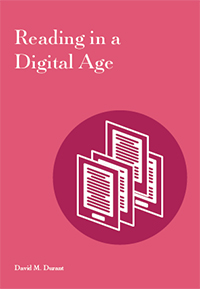
Reading in a Digital Age
Skip other details (including permanent urls, DOI, citation information): This work is licensed under a Creative Commons Attribution-NonCommercial-NoDerivatives 4.0 International License. Please contact [email protected] to use this work in a way not covered by the license.
For more information, read Michigan Publishing's access and usage policy.
Tilting the Balance to Print
I mentioned my own sympathy with the concerns of the digital skeptics at the beginning of this briefing. In my view, it is this evidence of what readers actually want, manifested in both sales data and expressed reader preferences, that tilts the balance in favor of those concerned about the fate of linear reading in the digital age. When you have a substantial percentage of tech-savvy millennial undergraduates, those you would least expect to be susceptible to what Thompson calls the “fabulous PR” accorded the print codex, making arguments for print that could be taken almost verbatim from Carr or Wolf, it is a powerful indicator that perhaps print and digital reading really are substantially different. The preference documented by Baron, albeit from a small sample of respondents, for reading long-form texts in print, seems to directly highlight the weakness of those studies supportive of digital reading’s ability to foster similar comprehension to print, based as they are on readings of very short texts in controlled environments.
It is, of course, possible that Thompson, Jones, and other champions of digital reading are correct, and the current stabilized status of print reading is merely a brief blip in a virtually inevitable transition to a digital reading future. The expressed preferences of many readers for print when engaged in linear reading could simply be a vestigial cultural holdover, doomed to disappear as a new generation who has known digital devices their entire lives comes of age and show that there is no fundamental difference in reading format. The flatlining of e-book sales might just be a temporary correction, awaiting only this generational transition and dissipation of old prejudices to take off once again.
I’m not so sure, however. As awareness of the distractions inherent to many of our digital devices has come to permeate society, even some of those most critical of the digital skeptics have recently modified their views. While Thompson may have read War and Peace on his smartphone to prove a point, Bilton returned to reading books in print in 2013, citing as his reasons the lack of distractions as well as the tactile qualities of reading a physical book, which the work of Mangen has shown to help with comprehension.[106] Similarly, Shirky now refuses to allow his students to use digital technology in the classroom without permission due to its distracting effects. In his words, “The industry has committed itself to an arms race for my students’ attention, and if it’s me against Facebook and Apple, I lose.”[107]
Even some of those most critical of the digital skeptics have recently modified their views.
There are, of course, many proponents of the dedicated e-reader, such as Jacobs, who would object by saying that devices like the Kindle or Nook have the ability to bridge the reading divide. However, even if we assume that dedicated e-readers succeed in preserving the experience of deep reading in a digital container, there is still the question of how popular such devices will prove to be over the long-term. As I’ve shown above, the data strongly suggest that the dedicated e-reader is losing out to the multipurpose tablet and even the smartphone.
If tablets and/or smartphones do become the primary device for digital reading, with all their attendant possibilities of distraction and multitasking, it does not bode well for those who hope that deep reading can be preserved in the digital environment. The New York Times summarized the danger in March 2012: “People who read e-books on tablets like the iPad are realizing that while a book in print or on a black-and-white Kindle is straightforward and immersive, a tablet offers a menu of distractions that can fragment the reading experience, or stop it in its tracks.”[108] Even if it is possible to engage in deep reading on a tablet, how many readers will choose to do so when Facebook or YouTube are just a click away, especially if their neural pathways have rewired themselves to want to seek the latter at the expense of the former?
There are, of course, those who would argue that the threat of distraction is nothing new. Postman, after all, warned of the threat to attention spans posed by television. Are not the present worries over reading in digital format simply a reflection of these earlier arguments? Unfortunately, in my view, this is an apples-and-oranges comparison. One can certainly make a case that the threat to our ability to engage in deep linear reading began with screen-based technologies such as movies and television. The main point to keep in mind, however, is that these technologies were completely self-contained and separate from the print codex. In the digital environment, by contrast, text, audio, and video are all brought to you on the same device. As Carr once famously observed, the Internet absorbs all previous information technologies and remakes them in its own image. In the digital environment, text ceases to be one distinct, self-contained format among many and becomes simply one form of content thoroughly integrated into the digital cornucopia. Television and film offered more stimulating alternatives while leaving the codex itself alone and unchanged. The digital information environment has granted the book no such luxury. That is why this time is indeed different. The threat to deep linear reading may not have originated in the digital age, but it has certainly greatly accelerated because of it.
This especially applies to the corollary argument that is often heard: How is the current threat of digital distraction any greater when reading an e-book versus a print codex? Isn’t it just as easy to put down a print book and pick up a tablet or smartphone as it is to close out your e-reading app and start browsing Facebook? The answer, in my view, is no, and again I return to neuroplasticity. The digital environment is literally rewiring our brains to seek stimulative, short-term gratification at the expense of our ability to think and read in depth. In this situation, how much more challenging is it to read at length on the very same screen from which your brain expects quick scanning, 140-character tweets, and amusing cat videos than it is to read from a printed page or on a dedicated e-reader that does not offer such opportunities for distraction?
Thus the digital reading environment offers not a difference in degree but a difference in kind, one that is transformational in nature rather than evolutionary. As the digital age unfolds, it is likely to substantially alter both the nature of reading and the nature of the book itself as deep linear reading fades in importance and functional tabular reading becomes more widespread than ever. This will in turn alter the way people write and even the ways they think, leading to a likely decline of deep analytical thought for the purpose of forming broad conceptual frameworks in favor of a more immediate, purely functional form of decision-oriented thinking based on rapidly acquired snippets of information.


